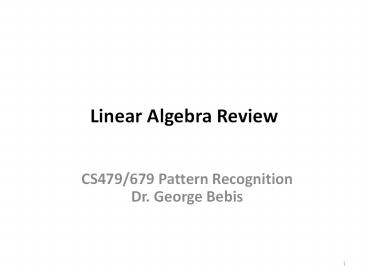Linear Algebra Review - PowerPoint PPT Presentation
Title:
Linear Algebra Review
Description:
Title: Image Processing Fundamentals Author: George Bebis Last modified by: George Bebis Created Date: 2/5/2001 12:45:24 AM Document presentation format – PowerPoint PPT presentation
Number of Views:69
Avg rating:3.0/5.0
Title: Linear Algebra Review
1
Linear Algebra Review
CS479/679 Pattern RecognitionDr. George Bebis
2
n-dimensional Vector
- An n-dimensional vector v is denoted as follows
- The transpose vT is denoted as follows
3
Inner (or dot) product
- Given vT (x1, x2, . . . , xn) and wT (y1, y2,
. . . , yn), their dot product defined as
follows
(scalar)
or
4
Orthogonal / Orthonormal vectors
- A set of vectors x1, x2, . . . , xn is orthogonal
if - A set of vectors x1, x2, . . . , xn is
orthonormal if
5
Linear combinations
- A vector v is a linear combination of the vectors
v1, ..., vk if - where c1, ..., ck are constants.
- Example vectors in R3 can be expressed as a
linear combinations of unit vectors i (1, 0,
0), j (0, 1, 0), and k (0, 0, 1)
6
Space spanning
- A set of vectors S(v1, v2, . . . , vk ) span
some space W if every vector in W can be written
as a linear combination of the vectors in S - - The unit vectors i, j, and k span R3
w
7
Linear dependence
- A set of vectors v1, ..., vk are linearly
dependent if at least one of them is a linear
combination of the others.
(i.e., vj does not appear on the right side)
8
Linear independence
- A set of vectors v1, ..., vk is linearly
independent if no vector can be represented as a
linear combination of the remaining vectors,
i.e.
Example
9
Vector basis
- A set of vectors (v1, ..., vk) forms a basis in
some vector space W if - (1) (v1, ..., vk) are linearly independent
- (2) (v1, ..., vk) span W
- Standard bases
R2 R3 Rn
10
Matrix Operations
- Matrix addition/subtraction
- Matrices must be of same size.
- Matrix multiplication
m x p
q x p
m x n
Condition n q
11
Identity Matrix
12
Matrix Transpose
13
Symmetric Matrices
Example
14
Determinants
2 x 2
3 x 3
n x n
Properties
15
Matrix Inverse
- The inverse A-1 of a matrix A has the property
- AA-1A-1AI
- A-1 exists only if
- Terminology
- Singular matrix A-1 does not exist
- Ill-conditioned matrix A is close to being
singular
16
Matrix Inverse (contd)
- Properties of the inverse
17
Matrix trace
Properties
18
Rank of matrix
- Equal to the dimension of the largest square
sub-matrix of A that has a non-zero determinant. - Example
has rank 3
19
Rank of matrix (contd)
- Alternative definition the maximum number of
linearly independent columns (or rows) of A.
Example
i.e., rank is not 4!
20
Rank of matrix (contd)
21
Eigenvalues and Eigenvectors
- The vector v is an eigenvector of matrix A and ?
is an eigenvalue of A if - i.e., the linear transformation implied by A
cannot change the direction of the eigenvectors
v, only their magnitude.
(assume non-zero v)
22
Computing ? and v
- To find the eigenvalues ? of a matrix A, find the
roots of the characteristic polynomial
Example
23
Properties
- Eigenvalues and eigenvectors are only defined for
square matrices (i.e., m n) - Eigenvectors are not unique (e.g., if v is an
eigenvector, so is kv) - Suppose ?1, ?2, ..., ?n are the eigenvalues of A,
then
24
Matrix diagonalization
- Given an n x n matrix A, find P such that
- P-1AP? where ? is diagonal
- Take P v1 v2 . . . vn, where v1,v2 ,. . . vn
are the eigenvectors of A
25
Matrix diagonalization (contd)
Example
26
Are all n x n matrices diagonalizable P-1AP ?
- Only if P-1 exists (i.e., P must have n linearly
independent eigenvectors, that is, rank(P)n) - If A is diagonalizable, then the corresponding
eigenvectors v1,v2 ,. . . vn form a basis in Rn
27
Matrix decomposition
- Let us assume that A is diagonalizable, then A
can be decomposed as follows
28
Special case symmetric matrices
- The eigenvalues of a symmetric matrix are real
and its eigenvectors are orthogonal.
P-1PT
APDPT































